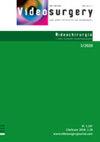改良床边麻花钻开颅术治疗慢性硬膜下血肿
IF 1.6
4区 医学
Q2 SURGERY
引用次数: 5
摘要
引言标准开颅术(SC)和毛刺孔开颅术(BHC)被认为是治疗慢性硬膜下血肿(CSDH)的标准方法。床边螺旋钻开颅术(TDC)是在患者床边进行的,作为标准方法的替代方法。然而,接受TDC和BHC/SC治疗的患者的临床和放射学特征尚未进行比较。目的阐明CSDH的具体特征,这些特征会影响外科医生在选择TDC患者时的偏好。材料和方法对2017年在一家机构接受CSDH治疗的32名患者进行回顾性分析。比较BHC/SC和TDC的基线放射学特征、入院时的临床状况、并发症发生率和临床结果。结果32例患者中,TDC治疗5例(15.6%),SC或BHC治疗27例(84.4%)。TDC手术的持续时间明显短于标准治疗的时间(p<0.01)。TDC和BHC/SC在基线临床特征方面没有差异,包括年龄、性别、头部创伤史、糖尿病、高血压、抗血小板药物使用,临床表现和格拉斯哥昏迷量表评分(均p>0.05)。与接受BHC/SC治疗的患者相比,接受TDC治疗的患者血肿明显较厚(TDC与BHC/SC:平均25.3 mm与14.6 mm)(p<0.01),中线偏移较小(TDC与BCC/SC:均0.5 mm与4.0 mm)(p=0.01)。结论与SC和BHC相比,麻花钻开颅术是一种更有效的CSDH排空方法。该手术被认为是治疗较厚、无间隔血肿和中线移位较小的患者的一线治疗。本文章由计算机程序翻译,如有差异,请以英文原文为准。
Modified bedside twist drill craniostomy for evacuation of chronic subdural haematoma
Introduction Standard craniotomy (SC) and burr hole craniostomy (BHC) are regarded as the standard approaches to chronic subdural haematoma (CSDH). Bedside twist drill craniostomy (TDC), performed at the patient’s bedside, was introduced as an alternative to the standard methods. However, clinical and radiological features of patients treated with TDC and BHC/SC have not been compared. Aim To demonstrate the specific features of CSDH that affect the surgeons’ preferences when selecting patients for TDC. Material and methods A retrospective analysis of 32 patients treated due to CSDH in the year 2017 at a single institution was performed. Baseline radiological characteristics, clinical status at admission, complication rate and clinical outcomes were compared between BHC/SC and TDC. Results Of the 32 patients, 5 (15.6%) were treated using TDC and 27 (84.4%) by SC or BHC. The duration of the TDC procedure was significantly shorter than the time of standard therapies (p < 0.01). There were no differences between TDC and BHC/SC in terms of baseline clinical characteristics, including age, gender, head trauma history, diabetes, hypertension, antiplatelet drug use, clinical manifestation and the Glasgow Coma Scale score (all p > 0.05). Patients treated with TDC had a significantly thicker haematoma (TDC vs. BHC/SC: mean 25.3 mm vs. 14.6 mm) (p < 0.01) and demonstrated a smaller midline shift (TDC vs. BHC/SC: mean 0.5 mm vs. 4.0 mm) (p = 0.01) compared to those treated with BHC/SC. Conclusions Twist drill craniostomy is a more effective method for CSDH evacuation compared to SC and BHC. This procedure is considered as the first line treatment for patients with a thicker and non-septated haematoma, and with a smaller midline shift.
求助全文
通过发布文献求助,成功后即可免费获取论文全文。
去求助
来源期刊
CiteScore
2.80
自引率
23.50%
发文量
48
审稿时长
12 weeks
期刊介绍:
Videosurgery and other miniinvasive techniques serves as a forum for exchange of multidisciplinary experiences in fields such as: surgery, gynaecology, urology, gastroenterology, neurosurgery, ENT surgery, cardiac surgery, anaesthesiology and radiology, as well as other branches of medicine dealing with miniinvasive techniques.

 求助内容:
求助内容: 应助结果提醒方式:
应助结果提醒方式:


